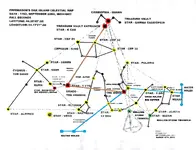Could the so called "90 foot Stone " the guys found actually be a replica ? Attached is a short article which has an eye witnesses state that the initials JM had been carved into the stone. Just food for thought:
https://ciphermysteries.com/2017/03/19/oak-island-ciphers-part-1-80-foot-rock-cipher
From article:
THE OAK ISLAND CIPHERS (PART 1): THE 80-FOOT ROCK CIPHER…
by nickpelling March 19, 2017
Yet… the 19th August 1911 edition of Collier’s Magazine contains an eyewitness account supplied by Captain H.L. Bowdoin that departs somewhat from the dominant narrative. He wrote:
“While in Halifax we examined the stone found in the Money Pit, the characters on which were supposed to mean: “Ten feet below two million pounds lie buried.” The rock is of a basalt type hard and fine-grained.”
“There never were any characters on the rock found in the Money Pit. Because: (a) The rock, being hard, they could not wear off. (b) There are a few scratches, etc., made by Creighton’s employees, as they acknowledged, but there is not, and never was, a system of characters carved on the stone.”
There was backed up thoroughly by a 27th March 1935 eyewitness statement by Harry W. Marshall, who was the son of one of the owners of Creighton & Marshalls:
One of the Creighton’s was interested in the Oak Island Treasure Co. and had brought to the city a stone which I well remember seeing as a boy, and until the business was merged in 1919 in the present firm of Phillips & Marshall. The stone was about 2 feet long, 15 inches wide, and 10 inches thick, and weighed about 175 pounds. It had two smooth surfaces, with rough sides with traces of cement attached to them. Tradition said that it had been part of two fireplaces. The corners were not squared but somewhat rounded. The block resembled dark Swedish granite or fine grained porphyry, very hard, and with an olive tinge, and did not resemble any local stone. Tradition said that it had been found originally in the mouth of the “Money Pit”. While in Creighton’s possession
some lad had cut his initials ‘J.M.” on one corner, but apart from this there was no evidence of any inscription either cut or painted on the stone. Creighton used the stone for a beating stone and weight. When the business was closed in 1919, Thos. Forhan, since deceased, asked for the stone, the history of which seems to have been generally known. When Marshall left the premises in 1919, the stone was left behind, but Forhan does not seem to have taken it. Search at Forhan’s business premises and residence two years ago disclosed no stone. The full history of the stone was written up in ‘the Suburban” about 1903 or 1904.




